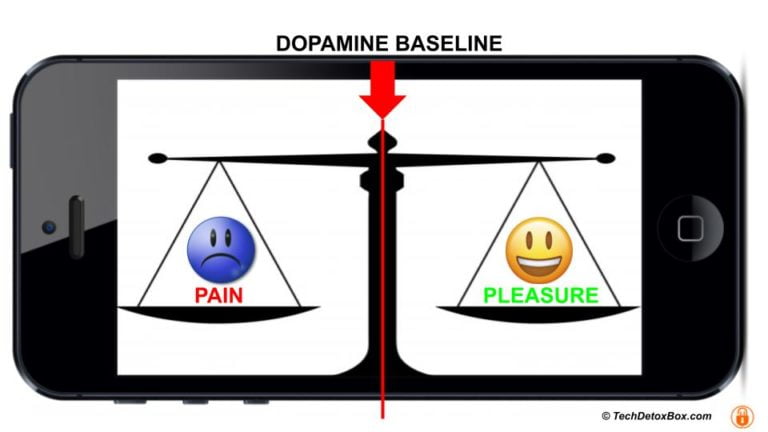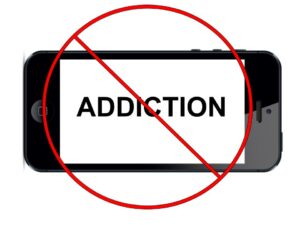Screen Dopamine Overload
How is the mental health epidemic connected to screen addiction? The answer is dopamine released in the young brain exposed to screens.
Dopamine is a neurotransmitter we need for survival: the brain releases dopamine when we eat, to remind the reward centers of our brain that we need food to live. But when we eat junk food, the amount of dopamine released is abnormally high. Those chips are especially formulated to be more enjoyable than healthy food. More addictive.
The same thing happens with screens – they release large amounts of dopamine. Reading a book releases an appropriate amount of dopamine, but a video game designed for addiction has a dopamine spike similar to cocaine.
Dopamine is a pleasure hormone that motivates us to do more of what we enjoy. Junk food, drugs and video games share the same brain chemistry of dopamine overload. And too much pleasure leads to addiction.
Screen Addiction by Design
Screen addiction is not a child’s fault: brain biology makes highly engaging digital media impossible to resist. Normal everyday activities produce healthy amounts of dopamine, but screens are designed to flood the reward centers of the brain: research shows that most addictive video games spike dopamine production 70-300% above baseline (for comparison – sex is a 100% above, cocaine 225%, and crystal meth is a 1000%).
Video game addiction is an officially recognized diagnosis. TikTok has one of the most addictive algorithms in the industry.
Digital heroin is the new drug.
Pleasure/Pain Balance
The brain always seeks to return to the balance of pain and pleasure, determined by the normal baseline level of dopamine. This process is called homeostasis – a state of stable equilibrium. Screen time dopamine overdose wreaks havoc on the pain/pleasure balance.
The brain has to compensate for too much screen time pleasure and tip the balance to the side of pain.
Baseline dopamine level is biologically normal for real life activities, but addictive screens destroy that baseline. The brain develops dopamine tolerance and starts producing less. In order to achieve the same “high”, kids now have to stay on the screen longer, and seek novel, more addictive screen experiences.
The majority of kids using screens are addicted to them and admit it themselves. The more they use, the more they have to use. Their dopamine baseline is erased, and pleasure/pain balance is out of whack. Like drug addicts, they are trapped in the downward spiral of addiction.
From Addiction to Depression and Anxiety
As the brain on screens compensates for overproduction of dopamine by producing less, kids no longer get any pleasure from things they used to enjoy. Healthy dopamine activities like playing outside or spending time with family are not enjoyable anymore – the brain now expects the dopamine flood that can only come from screens. So they have to spend more and more time on their phone in the desperate attempt to make themselves happy.
With the reward pathways in the brain broken, a neurological condition known as anhedonia sets in – inability to feel pleasure from anything. Nothing in the real world – a walk in the park or a conversation with a loved one – is pleasurable anymore. What used to produce normal amounts of dopamine when the brain was healthy, now generates much less because of dopamine tolerance.
Without the constant stimulation of new digital experiences to spike dopamine, kids get irritable and anxious. Like the drug addict who needs more potent drugs in higher quantities to reach the same high, they seek more and more dopaminergic screen activities – more extreme video games, high frequency social media, scrolling through short clips of increasingly shocking content. It’s a vicious cycle that leads to even more dopamine tolerance in the brain, and now even the video games that used to satisfy no longer do.
The downward spiral of screen overuse continues until there are simply not enough hours in the day to generate enough dopamine even from the most engaging digital experiences, and the child ends up in a psychiatrist’s office with a diagnosis of depression.
Mental health epidemic among the young is a dopamine illness. Dopamine malfunction is directly linked to depression, anxiety, low self-esteem, ADHD, anger, and social withdrawal.
Dopamine tolerance eventually leads to complete inability to derive pleasure from anything – on screen or in real life.
Nothing satisfies anymore. It’s the end of all joy and happiness.
Young Brain and Addiction
Why is digital addiction especially dangerous for the young? Frances E. Jensen in her book The Teenage Brain: A Neuroscientist’s Survival Guide to Raising Adolescents and Young Adults explains how the growing brain works.
First, screens compromise normal brain development. Adolescent brain is under construction. Neural connections are formed, and the pathways that are not used are pruned away. Because of screens, kids miss developmental milestones for social skills. Delayed gratification ability and imagination atrophy. Instead, the brain is shaped by toxic, low-effort, high-reward screen activities.
Second, the young brain is prone to addiction: 90% of all adult additions begin in adolescence. Once the addiction is hard-wired in the growing brain, it’s hard to break. The child does not want to do anything but screens. But high dopamine produced by screen activities is unsustainable. The brain will compensate with the pain of depression and anxiety.
Third, the young brain is overly emotional: when things are bad, they are really bad, and the rational brain is not yet developed to regulate intense negative feelings. When validation only comes from social media, online bullying is common, and there is no escape from 24/7 connectivity, mental health breaks down. The most extreme outcome is suicide.
Solutions for Digital Addiction
Digital Detox
The cure for addiction is to cut access to the drug: the remedy is to take screens away, and suffer the withdrawal. Brain plasticity is the good news here: once toxic screens are removed, the brain can heal itself and reestablish normal dopamine production.
Real Life Experiences
Kids need to re-engage with real life experiences to rebuild a healthy dopamine baseline: read, play, go outside, be with people. Face-to-face relationships are particularly beneficial, according to the longest study of human happiness.
Delay Screens
Wait with the smartphones until kids grow up. We protect them from drugs and alcohol, we should also protect them from addictive digital activities to give their brains time to mature. Kids do not have the self-control to consume digital drugs in moderation.
Take Back Control
Sign up for our monthly newsletter to receive latest digital wellbeing research and screen time management solutions. We never share your email with third parties.Share this:
- Click to share on X (Opens in new window) X
- Click to share on Facebook (Opens in new window) Facebook
- Click to share on LinkedIn (Opens in new window) LinkedIn
- Click to share on Pinterest (Opens in new window) Pinterest
- Click to email a link to a friend (Opens in new window) Email
- Click to print (Opens in new window) Print



